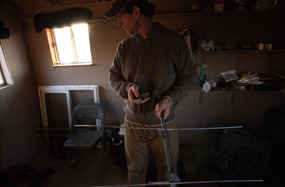|
You are viewing ARCHIVED content published online before January 20, 2025.
Please note that this content is NOT UPDATED, and links may not work. For current information,
visit https://www.nps.gov/aboutus/news/index.htm.
Contact: Bear Gulch Visitor Center, (831)389-4485 ext 235

Daniel Cressman/The Pinnacle Newspaper Tuesday, April 24, two California condors took their first flight to freedom at PinnaclesNational Monument. Condors 400 (a female reared by parents, hatched on 04/11/06 at the World Center for Birds of Prey, The Peregrine Fund) and 401 (a male reared by parents, hatched on 04/13/06 at the World Center for Birds of Prey, The Peregrine Fund) are now members of the parks free flying flock of 15 condors. “Each took short awkward flights with a few of the previously released birds,” explained Jim Petterson, Supervisory Wildlife Biologist at PinnaclesNational Monument. “We will monitor these two for a couple days and if they integrate well with the flock, we will continue to release the remaining three birds,” continued Petterson. While the new condors are experiencing their first taste of freedom, previously released condor 332 is recuperating at the Los Angeles Zoo from an injury to his wing that occurred last week. He underwent a two hour operation to clean up a five inch wound on the leading edge of his left wing. The tendons and bones associated with that wing were not seriously damaged and the prognosis for his recovery is good. He will probably be at the zoo for a few weeks before returning to Pinnacles for re-releasing. The likely scenario that led to his injury was that he struck something while flying (e.g. a powerline or tree branch) and there was no evidence of a gunshot wound. The two newest free flying condors were released using the same method attempted at the publicly attended release event over the weekend. Over 500 people made the journey to Pinnacles for this year's condor release event. Even though no condors ended up leaving the flight pen, several of the free-flying Pinnacles condors were soaring near the viewing area, which gave everyone a chance to see these endangered birds. All of the Pinnacles releases have been “soft releases” using a double-door trap because it is less stressful on the birds. This technique relies on using a special trap built into the side of the flight pen, one door being open to the inside of the pen and the other to outside and freedom. The interior door normally remains open to allow the condors to become familiar with the interior of the trap. For release purposes, once a condor enters the trap, the inner door is closed and the outer door is opened to allow it to fly free. Ultimately, project biologists anticipate releasing a sustainable population of up to 30 condors at Pinnacles, a historic breeding ground for the massive birds. The reintroduction of California condors to Pinnacles is a cooperative effort between the Ventana Wildlife Society, Pinnacles Partnership, and the National Park Service in partnership with the California Condor Recovery Team. |
Last updated: February 28, 2015
